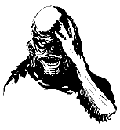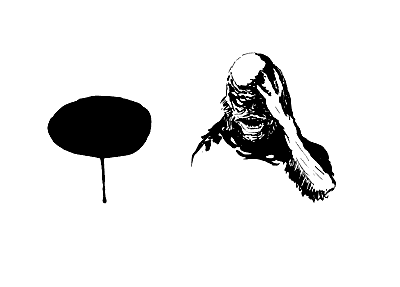|
Each poem is a single page in length and presented on the left-hand page. An image by Yackulic appears on the right. Padgett’s ‘Scary Movie’ opens the book, and is of the inner body. ‘Now we can go down our own throats,’ he writes, ‘by looking at a TV monitor attached / to a tube at the end of which is / a tiny camera, a third eye / like the one in mysticism....’ The poem continues in this way, from the awful intrusion of the medical industry toward a surrealist vat of imagery, a bog ‘silently vibrating / with the souls of the ducks who /died there, shot down by hunters / with blunderbusses and mutton chops / and monocles on thin gold chains....’
Yackulic’s accompanying drawing here as elsewhere in the book compliments the poem only indirectly. His drawings like visual representations of events in the Comte de Lautréamont’s Maldoror starkly relate vivid emotional or existential conditions. On this page opposite Padgett’s poem is a man in a black cape holding, perhaps, a valise. A long feather extends from a hip black hat. The points of his moustache are waxed. He looks through a vibrational field toward an abstract source, like a black, oblong sun. These words are beneath: ‘...the boat creaks in the bay in 1892.’ That year 1892 I think is a key to the drawings and to the inspiration behind this paranormal research. Decadent, symbolist themes dominate in one form or other here. The images aren’t as elaborate as, say, Gustave Moreau’s Les Chimères, but there are shared elements of destabilization, freakish surprise and humorous metamorphoses.
‘One thing is dominant in me,’ Moreau once said, ‘the ardent attraction of the abstract. The expression of human feelings, of the passions, interests me no doubt, but I am less inclined to express these movements of the soul than to make visible, so to speak, the inner flashes of illumination which we cannot explain, which have something divine about them, and which, translated by the marvelous effects of pure plastic art, open up magical perspectives.’
Moreau reaches his illuminations with exuberance and a kind of abandon unlike Yackulic’s more minimalist, angst-driven forms. An image accompanying Brandon Downing’s almost verbless list poem ‘CVII.’ shows an egg-headed young man in a plaid shirt holding a camera. The commentary can be interpreted in several ways, of course, but it fails to achieve some of the more interesting insights found in other works that are more complex symbolically.
Joanne Kyger’s piece about a mysteriously shattered glass and a ‘friend’s / ashes, the small portion I have, still to be / buried,’ is presented beside the image of a boy holding a doorknob. Traces or outlines of three other figures retreat behind him. It’s a simple image of melancholy or, since melancholy no longer exists, depression. But the door, the possibility of its being opened by the boy and the disintegration of form into shadow is evocative and mysterious. Though more subdued, there are distant correspondences between this and those Decadents like Moreau, Toorop and Redon.
Novalis comments on ‘the mysterious road which leads to the interior,’ another apt phrase to describe this unusual and welcome book. Against the mundane realities and accumulations of facts under capitalism, the paranormal represents inner lives ripped from physical life. Our post-modern version is less ambitious, less enthused than the Decadents.
It’s not a problem of the artist or the writers of this book; it’s a sign of the inert conditions we inhabit where ideals of liberty, freedom and democracy seem to have deflated into the same old prisons. Only now the masters are ourselves, regulating our services to a weak and deflated economy. Against this, and because religion and God are dead, the paranormal still attracts our senses. Invisible life certainly still matters, but now it’s less defined, more disorganized and alien to us without those old structural formalities. Poetry, perhaps, and for now only, is the last capable outlet for the invisible phenomena matter withholds.
‘It’s like it builds a hill at the base of your brain,’ writes Clark Coolidge, ‘watch out for the whippoorwills and fireflies / did they get you him her whatever?’ Here the intrusion of the natural world registers anxiety in the poem. ‘Strange days,’ he says, ‘have found us.’ Opposite this Yackulic’s genderless bubble monster dreams of a brain. A note beside the creature reads: ‘...and then my dreams had dreams.’
In ‘Lemon Trees,’ Eileen Myles voices this anxiety, as if our days and our desires ceased to correspond, losing ourselves in the rushing of things we must do against the things we claim our own.
My head broke up through
a hole in the ice
It was California
The states had flickered
by like a walking
miracle
what day is this?
what am I expected
to do
there could be
worse fates
this is not the book
I wrote
or inherited
the air is clean.
Yackulic’s leaf monster (‘easily smashed’) is presented with this poem. Such an image reveals in an instant the kind of world we inhabit.
Karen Weiser, Hoa Nguyen, Kevin Opstedal, Noel Black and others all present marvelous work too, inspiring curiosity for ‘your skull gone green,’ a soul ‘green and growing,’ jade blossoms in a tree ‘next to the / tree that is rotting and full of flies’ and ‘some kind of Delta blues disturbance.’ John Ashbery’s ‘Theme Park Days’ closes the book: ‘There was handwriting on one side, “spirit handwriting,” he indicated with a motion of his head. Yet it all seemed for naught, ancient stock-market quotations or chalked messages on hoardings of the last century, with plus and minus signs featured prominently.’ Here, too, ‘Vibrations of crisp mornings ripple ever closer.... Delphic squibs caparison the bleak afternoon and the critics love it, eat it up, can’t get enough of it....’ This is an exuberant poem where so many fields collide. The paranormal is felt in this flux, registered in provisory, mid-sentence image drafts of uncertain but exquisite findings.
Yackulic’s final drawing, a monster (modelled loosely on the Creature from the Black Lagoon, 1956) holding his head in pain or forgetfulness, contains also a black, wordless cartoon bubble. It’s as if the paranormal condition has reversed somehow, Burroughs’ word virus projected back onto matter. The invisible world disappears, consumed by monsters everywhere. From now on there will be only hard facts on display. The image is a warning: when the world of language is gone, so too the paranormal.
Illustration (detail) from the final page of the book copyright © Will Yackulic 2003
|


